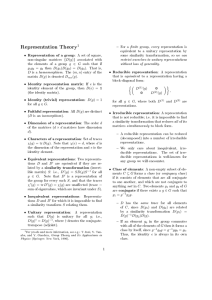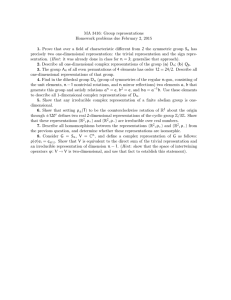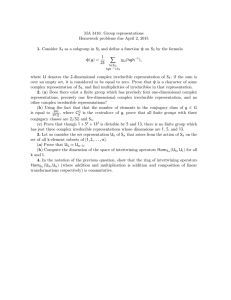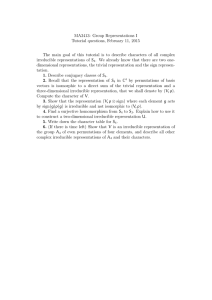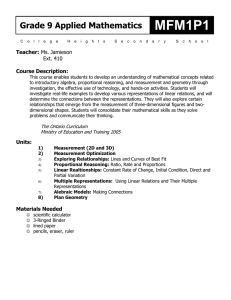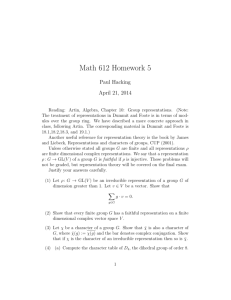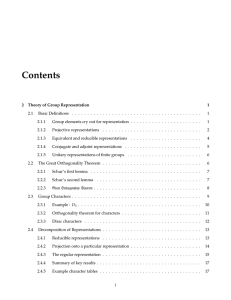Representation Theory 1
advertisement
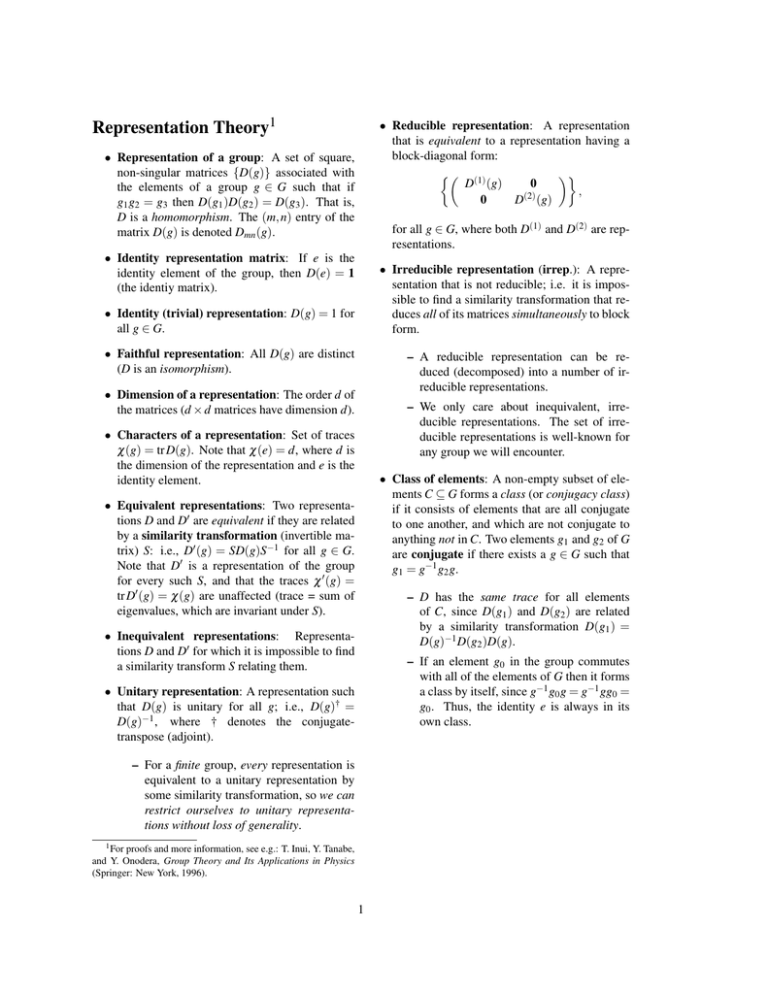
Representation Theory1
• Reducible representation: A representation
that is equivalent to a representation having a
block-diagonal form:
(1)
D (g)
0
,
0
D(2) (g)
• Representation of a group: A set of square,
non-singular matrices {D(g)} associated with
the elements of a group g ∈ G such that if
g1 g2 = g3 then D(g1 )D(g2 ) = D(g3 ). That is,
D is a homomorphism. The (m, n) entry of the
matrix D(g) is denoted Dmn (g).
for all g ∈ G, where both D(1) and D(2) are representations.
• Identity representation matrix: If e is the
identity element of the group, then D(e) = 1
(the identiy matrix).
• Irreducible representation (irrep.): A representation that is not reducible; i.e. it is impossible to find a similarity transformation that reduces all of its matrices simultaneously to block
form.
• Identity (trivial) representation: D(g) = 1 for
all g ∈ G.
• Faithful representation: All D(g) are distinct
(D is an isomorphism).
– A reducible representation can be reduced (decomposed) into a number of irreducible representations.
• Dimension of a representation: The order d of
the matrices (d × d matrices have dimension d).
– We only care about inequivalent, irreducible representations. The set of irreducible representations is well-known for
any group we will encounter.
• Characters of a representation: Set of traces
χ(g) = tr D(g). Note that χ(e) = d, where d is
the dimension of the representation and e is the
identity element.
• Class of elements: A non-empty subset of elements C ⊆ G forms a class (or conjugacy class)
if it consists of elements that are all conjugate
to one another, and which are not conjugate to
anything not in C. Two elements g1 and g2 of G
are conjugate if there exists a g ∈ G such that
g1 = g−1 g2 g.
• Equivalent representations: Two representations D and D0 are equivalent if they are related
by a similarity transformation (invertible matrix) S: i.e., D0 (g) = SD(g)S−1 for all g ∈ G.
Note that D0 is a representation of the group
for every such S, and that the traces χ 0 (g) =
tr D0 (g) = χ(g) are unaffected (trace = sum of
eigenvalues, which are invariant under S).
– D has the same trace for all elements
of C, since D(g1 ) and D(g2 ) are related
by a similarity transformation D(g1 ) =
D(g)−1 D(g2 )D(g).
• Inequivalent representations: Representations D and D0 for which it is impossible to find
a similarity transform S relating them.
– If an element g0 in the group commutes
with all of the elements of G then it forms
a class by itself, since g−1 g0 g = g−1 gg0 =
g0 . Thus, the identity e is always in its
own class.
• Unitary representation: A representation such
that D(g) is unitary for all g; i.e., D(g)† =
D(g)−1 , where † denotes the conjugatetranspose (adjoint).
– For a finite group, every representation is
equivalent to a unitary representation by
some similarity transformation, so we can
restrict ourselves to unitary representations without loss of generality.
1 For proofs and more information, see e.g.: T. Inui, Y. Tanabe,
and Y. Onodera, Group Theory and Its Applications in Physics
(Springer: New York, 1996).
1
• The Great Orthogonality Theorem: Denote
the inequivalent unitary irreducible representations of G by D(α) , where α = 1, · · · , nr . Then:
(α 0 )
(α)
∑ Dmn (g)∗ Dm0 n0 (g) =
g∈G
for all g ∈ G.
– Different partner functions of unitary ir(α)
(α 0 )
reps. are orthogonal: If φi and ψi0 are
partner functions in a Hilbert space, then
(α)
(α 0 )
hφi , ψi0 i = 0 if i 6= i0 or α 6= α 0 .
|G|
δ 0δ 0δ 0,
dα αα mm nn
where |G| is the number of elements in G, dα
is the dimension of the representation D(α) , and
δi j is the Kronecker delta (= 1 if i = j, = 0 otherwise).
• Projection operator: Any function ψ(x) can
(α) (α)
be decomposed ψ = ∑α ∑i ci φi as a sum of
(α)
components φi that are partner functions of a
unitary irrep. D(α) , with some expansion coeffi(α)
cients ci . These components can be found via
(α) (α)
(α)
(α)
ci φi = P̂i ψ, where P̂i is the projection
operator
• Character table: The table of characters
(traces) associated with each class (columns of
the table) and each irreducible representation
(rows of the table). The entries of the table obey
the following rules, and in fact can often be constructed directly from these rules without knowing the representations:2
(α)
P̂i
– Number of irreducible representations nr
= number of classes nc .
– ∑α dα2 = |G|. (This severely restricts the
dimensions of the representations.)
– From the trace (∑m=m0 ∑n=n0 ) of the orthogonality theorem we find that the rows
of the character table are orthogonal to one
another, when scaled by the number of elements in each class:
|G|δαα 0
=
(α)
• Product representations: given two irrep.
0
partner functions φ (α) and ψ (α ) , then their
0)
(α)
(α
product γ(x) = φ (x)ψ (x) must decompose in a particular way into irrep. partner functions. P̂(β ) γ 6= 0 if and only if
0
g∈G
=
∑ χ (α) (Ci )∗ χ
dα
(α)
∑ Dii (g)∗ Ôg .
|G| g∈G
The
operator
P̂(α) = ∑i P̂i
=
dα
(α)
∗
χ
(g)
Ô
projects
ψ
onto
its
com∑
g
g
|G|
ponents that transform according to the
representation D(α) .
∑ χ (α) (g)∗ χ (α ) (g)
(α 0 )
=
h
i
0
1
χ (β ) (g)∗ χ (α) (g) χ (α ) (g) 6= 0.
∑
|G| g∈G
(Ci )|Ci |,
Ci
(α)
where the Ci are the classes (with |Ci | elements), using the fact that every element
of a class has the same trace.
– It also turns out that the columns of the
character table are orthogonal:
|G|
∑ χ (α) (Ci )∗ χ (α) (C j ) = δi j |Ci | .
α
(α)
• Partner function: A set {φi (x)} of functions that transform according to D(α) , with
i = 1, · · · , dα . That is, if Ôg is the operator that
transforms φ according to g ∈ G, then
(α)
Ôg φ j
(α)
= ∑ φi
(α 0 )
[More generally, the products φi ψ j of two
full sets of partner functions transform as a rep0
resentation D(α×α ) of dimension dα dα 0 , and
the above sum is an integer that gives the number of times a representation β appears in this
(often reducible) product representation.] Product representations are most famous as the reason for selection rules in physics, determining
0
when hζ (β ) , φ (α) ψ (α ) i = 0 by symmetry.
(α)
Di j (g)
i
2 There
is a fifth rule about “products of classes” that is very
rarely needed to determine the character table uniquely.
2

